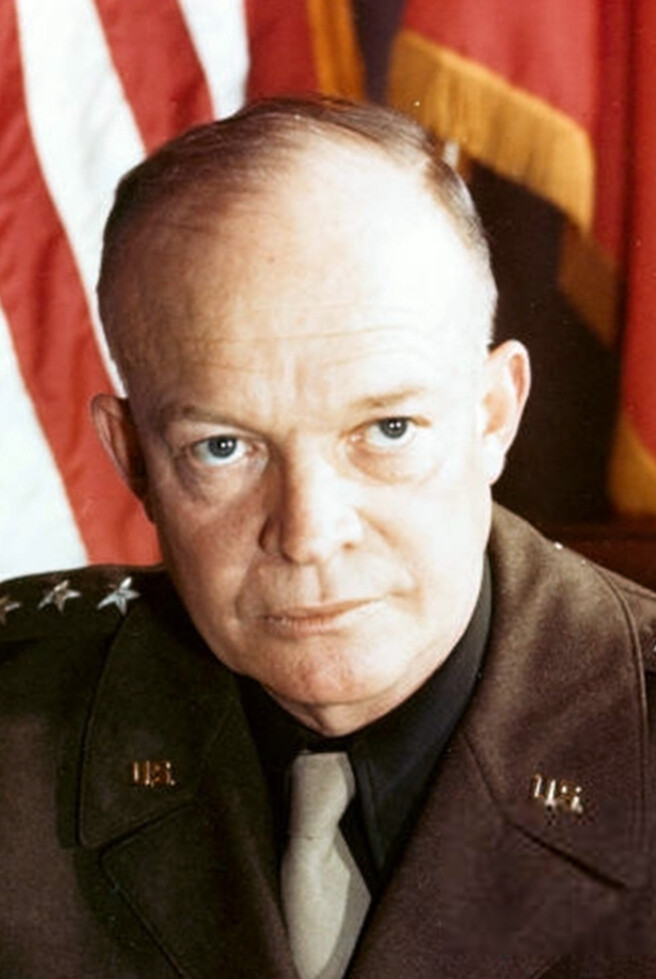Leaders of the second front –
Eisenhower is a ‘sure thing guy’ who whips enemy mathematically
Piles up weapons until he has superiority – then strikes hard
By Boyd Lewis, United Press staff writer
A handful of Allied leaders are being trusted to plan and lead the “second front” which the Anglo-American powers are expected to send across the English Channel soon. Who are these men? What are they like? Are they capable of the jobs assigned to them?
Boyd Lewis of the United Press War Desk has written a series of articles, telling about those men. In the following, the last of the series, he discusses Generalissimo Eisenhower.

When you fight the way Gen. Dwight D. Eisenhower fights, you can telegraph your punch to the enemy and get away with it.
The Allied “second front” invasion generalissimo is a “sure thing artist,” who believes in oiling up so much of everything on his side that the enemy doesn’t have a chance.
It was that way in Sicily and in Italy. He made no secret of his intention to attack either objective. When “mathematical Ike” was ready, he rolled. He knew the enemy might halt him temporarily at one point or another, but he also knew that it could not halt him everywhere because he had more of everything that it takes to do modern battle.
Along with the planes, ships and guns, Gen. Eisenhower gathers to his side a team of the best available brains. He has created a new kind of war-making, replacing the traditional staffs, each working on its own plans and tied by liaison to the others, with a hard-hitting, imaginative team of the best available fighting brains – land, sea and air – of two nations.
Same tactics used
In previous dispatches in this series, the characteristics of the fighting team captained by the big smiling, muscular man from Texas were examined. By viewing them in lineup, some idea of how Gen. Eisenhower plans to stage the March on Berlin can be glimpsed. Presumably the enemy gets the same ideas because “Ike” has whipped him in the Mediterranean with the same kind of team tactics.
Here is the top Allied invasion lineup:
Eisenhower:
Captain, coordinator, inspirational leader, American.
Air Chf. Mshl. Sir Arthur Tedder:
Deputy commander, advocate of “carpet bombing” to blast an avenue of destruction through an enemy defense position, British.
Adm. Sir Bertram Home Ramsay:
Hero of the Dunkirk evacuation and master of amphibious landing operations, British.
Air Marshal Trafford Leigh-Mallory:
Air commander-in-chief, fighter-pilot supreme, expert on the use of fighter cover for cooperation with ground forces, British.
Lt. Gen. Carl Spaatz:
Commander of the strategic bombing force, exponent of the late Gen. Billy Mitchell’s theory that air attack alone can – if adequately applied – reduce any enemy fortification afloat or on land, the man who will rain explosives across the length and breadth of Hitler’s Fortress Europe while the amphibious force springs the front gate, American.
Gen. Sir Bernard L. Montgomery:
Commander of the British ground forces, hero of El Alamein and the 8th Army’s march across North Africa and Sicily up the shrank of the Italian boot.
There still remains one vacant position in this list, that of the American ground commander.
The “punch” which Gen. Eisenhower has telegraphed thus would appear to shape up like this:
-
A terrific pasting by airplane of the entire vulnerable section of seacoast, along with bombing of communications lines supplying the area.
-
A massive air assault on the “carpet” plan, aimed at breaching the enemy fortifications.
-
An amphibious assault, covered from the sea by naval bombardment and from the air by an umbrella of fighters, pouring through a breach and fanning out beyond.
-
A continuous bridge of ships and landing craft bringing reinforcements and supplies – probably well over the 3,000 craft used in the Sicilian invasion.
Certain other features may be forecast from knowledge of the Eisenhower team. One early objective will be to gain control of a seaport so that large supply vessels may be utilized, as in Sicily. Another will be to snatch airports away from the enemy. In the first phase, the planes may operate from the British shore but before any substantial progress inland can be made, the Allies will need forward bases for fighters. Gen. Montgomery has characterized modern warfare as a struggle for airports.
One more forecast
It would seem logical that there be one or more diversionary blows to cause the enemy to waste his forces and continue him as to the place the main force will aim.
One more forecast is possible on the basis of Gen. Eisenhower’s previous fighting – that the European invasion will see the greatest utilization of artillery of any war in history. Germany has had plenty of time to prepare for this attack and will be well dug in. There will be no swift, mobile slashing by mounted columns.
Behind this attack will be the good-humored Gen. Eisenhower, born in Texas, reared in Kansas, educated at West Point. The name handed down by his Swiss forebears generations ago means to the Germans “iron beater,” an appropriate name for the man chosen to forge the weapon with which the Allies hope to bring Germany to her knees in 1944.